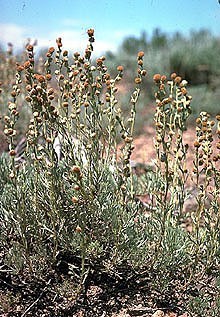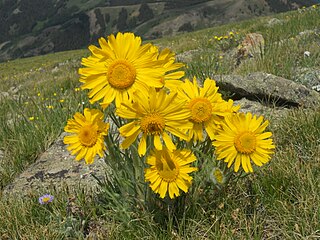
Ionactis, common name stiff-leaved asters or ankle-asters, is a small genus of plants belonging to the family Asteraceae. These aster-like plants are endemic to North America. One species is widespread across much of the eastern half of the continent, while two others are rare endemics with very restricted ranges.

Chrysopsis are plants in the family Asteraceae native to the southern and eastern United States. All the species are found in Florida, although some are found in other states as well.

Ionactis alpina is a species of flowering plant in the family Asteraceae known by the common name lava aster. It is native to western United States from California to Montana, where it grows in dry areas.

Ionactis linariifolia also known as the flax-leaf ankle-aster, flaxleaf whitetop or simply aster is a North American species of plants in the family Asteraceae.

Symphyotrichum ascendens is a species of flowering plant in the family Asteraceae known by the common names western aster, long-leaved aster, and Rocky Mountain aster. Blooming July–September, it is native to western North America and can be found at elevations of 500–3,200 m (1,600–10,500 ft) in several habitats.

Potentilla diversifolia or Potentilla × diversifolia is a species of flowering plant in the Rose Family (Rosaceae) known by the common names varileaf cinquefoil, different-leaved cinquefoil, and mountain meadow cinquefoil.

Artemisia papposa is a species of flowering plant in the aster family known by the common names Owyhee sage, Owyhee sagebrush, and fuzzy sagebrush. It is native to the Snake River Plain and surrounding areas in the northwestern United States, occurring in southern Idaho, eastern Oregon, and northern Nevada.

Artemisia rigida is a species of flowering plant in the aster family known by the common names scabland sagebrush and stiff sagebrush. It is native to the northwestern United States, in Washington, Idaho, and Oregon. It has been recorded in western Montana but these sightings may have been misidentifications.
Parthenium alpinum is a species of flowering plant in the aster family known by the common names alpine feverfew and Wyoming feverfew. It is native to Wyoming, Colorado, and New Mexico in the United States.

Erigeron leiomerus is a rare species of flowering plant in the family Asteraceae known by the common names rockslide yellow fleabane or rockslide fleabane. It is native to the western United States, primarily in the Rocky Mountains and the Great Basin. It has been found in Montana, Idaho, Nevada, Utah, Wyoming, Colorado, and New Mexico.

Erigeron tweedyi, or Tweedy's fleabane, is a perennial herb in the family Asteraceae. It is native to the Rocky Mountains in Montana, Idaho and Wyoming.
Eucephalus glaucescens is a North American species of flowering plant in the family Asteraceae known by the common name Klickitat aster. It grows on rocky slopes and in subalpine meadows at high elevations on and near Mount Adams in the south-central part of the US State of Washington.

Helianthella quinquenervis, the fivenerve helianthella, is a North American plant species in the family Asteraceae. It grows in the mountains of the western United States and northern Mexico. This include the Rockies, the Black Hills, the ranges of the Great Basin, and the northern Sierra Madre, from Montana, Oregon, and South Dakota south as far as western Chihuahua and Coahuila.

Eurybia glauca is a North American species of flowering plants in the family Asteraceae, called the gray aster. It is native to the western United States, primarily in Arizona, New Mexico, Utah, Colorado, and Wyoming, with a few populations in Idaho and Montana.

Hymenoxys grandiflora is a North American species of flowering plant in the daisy family known by the common names graylocks four-nerve daisy, graylocks rubberweed, or old man of the mountain. It is native to high elevations in the Rocky Mountains of the western United States.

Ionactis caelestis, the Spring Mountain aster, is a rare North American species in the family Asteraceae. It has been found only in southern Nevada in the western United States.
Ionactis elegans, the Sierra Blanca least-daisy, is a rare North American species in the family Asteraceae. It has been found only in New Mexico in the western United States.

Symphyotrichum porteri is a species of flowering plant in the family Asteraceae endemic to the foothills of the Rocky Mountains in the U.S. states of Wyoming, Colorado, and New Mexico. Commonly known as Porter's aster, it is a perennial, herbaceous plant that may reach 10 to 50 centimeters tall. Its flowers have white, rarely pinkish, ray florets and yellow, becoming pink then brown, disk florets. S. porteri grows at elevations of 1,800–2,900 meters. Its limited range makes it a NatureServe Vulnerable (G3) species, and it is classified Critically Imperiled (S1) in Wyoming.














